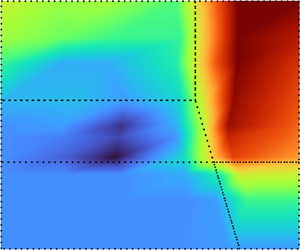Published online by Cambridge University Press: 15 March 2024

The properties of multiphase flows are challenging to measure, and yet effective properties are fundamental to modelling and predicting flow behaviour. The current study is motivated by rheometric measurements of a gas-fluidized bed using a coaxial rheometer in which the fluidization rate and the rotational speed can be varied independently. The measured torque displays a range of rheological states: quasistatic, dense granular flow behaviour at low fluidization rates and low-to-moderate shear rates; turbulent toroidal-vortex flow at high shear rates and moderate-to-high fluidization rates; and viscous-like behaviour with rate-dependent torque at high shear rates and low fluidization or at low shear rates and high fluidization. To understand the solid-like to fluid-like transitions, additional experiments were performed in the same rheometer using single-phase liquid and liquid–solid suspensions. The fluidized bed experiments are modelled as a Bingham plastic for low fluidization rates, and as a shear-thinning Carreau liquid at high fluidization rates. The suspensions are modelled using the Krieger–Dougherty effective viscosity. The results demonstrate that, by using the effective properties, the inverse Bingham number marks the transition from solid-like to viscous-flow behaviour; a modified gap Reynolds number based on the thickness of the shear layer specifies the transition from solid-like to turbulent vortical flow; and a gap Reynolds number distinguishes viscous behaviour from turbulent vortical flow. The results further demonstrate that these different multiphase flows undergo analogous flow transitions at similar Bingham or Reynolds numbers and the corresponding dimensionless torques show comparable scaling in response to annular shear.